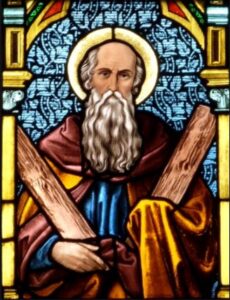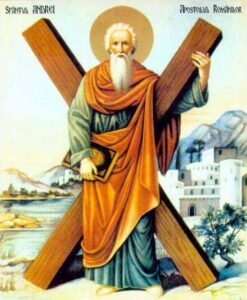Apostle St. Andrew – Nov 30 I The Protokletos – The First Called

Andrew is often known as the man, who introduced others to Jesus. Andrew was a native of Bethsaida of Galilee (Jn. 1: 44). He was the son of John / Jonas (Matt. 16: 17; Jn. 1: 42; and brother of Simon Peter (Matt. 10: 2; Jn. 1: 40). Both were fishermen by trade (Matt. 4: 18; Mk. 1: 16). Jesus called them when they were plying their trade and casting their nets into the sea (Mk. 1: 16-18; Matt. 4: 18-20). At the beginning of Our Lord’s public life, they occupied the same house at Capernaum (Mk. 1: 21, 29). The name ‘Andrew’ (Gk. Andreas – manly, manhood, and valour), appears in lists of apostles in the first four. John tells the story of Andrew being the first, to be called by Jesus, along with John (Jn. 1: 35-39). In the early Church Andrew is frequently called by the title ‘Protokletos’, which means ‘first called’. Andrew was the first to know Jesus as the ‘Messiah’, when he heard his master address Jesus as “Lamb of God”. He hastened to introduce his brother, Peter to Him. Andrew began as a follower and disciple of John the Baptist (Jn. 1: 40). He and Peter remained as disciples of St John, the Baptist prior to their final call by Christ, to His apostolate when they finally left everything to follow Jesus.
One would see the greatness of Andrew, who wished to share everything with his brother Peter. He was never in or one of the ‘inner circle’, but on some occasions he must have been on the fringe of it. He joined the three in asking Jesus the questions about the things to come (Mk. 13: 3). He is perhaps the next of the best known three disciples. In addition to this scanty information, we learn about Andrew in the fourth Gospel that it was he who brought the lad with five loaves of barley breads and two fishes to Jesus (Jn. 6: 8-9). On the third occasion the Greeks requested Philip to see Jesus. Philip consulted Andrew and Andrew had no doubt that they must be brought to Jesus (Jn. 12: 20-22). So, we see three incidences when Andrew emerges form the background, and on every occasion he introduces someone to Jesus.
- We see Andrew bringing and introducing Peter to Jesus – A missionary that began to work from home. He became the first missionary when he brought his own brother to Lord Jesus. It very often happens that one who is looking to do something for Jesus will find the opportunity in his own home
- Andrew brings the lad to Jesus during the feeding of the 5000 men. – (Jn. l: 40-42) It was Andrew who told Christ of the boy with five loaves and two fish at the feeding of the five thousand. It was his first local mission works (John 6: 8-9). He was eager to bring to Christ anyone who could be possibly be, of use to Jesus, even if it be a little.
- He brings the Greeks to Jesus. Andrew, because of the instigation of Philip, diplomatically handled the situation of dealing with a group of Gentiles who wanted to meet Jesus and was thus the first foreign missionary. Greeks visiting Jerusalem had approached Philip about meeting Jesus; Philip was not courageous enough, but Andrew arranged it (John 12: 20-22). – He understood Jesus so well that there was no one that Jesus would not like to see. And that Jesus was never busy to give Himself to the seeking and the inquiring searcher for the truth.
Andrew is not named in Acts, except for the list of the twelve, he has no epistles nor does the Apocalypse mention him. However a 3rd century work ‘Acts of Andrew depicts many miracles and journeys with Simon Peter. This brings to an end the information of Andrew in the N. T. However legend and tradition wove many stories around him. Andrew is connected with three different countries.
- Tradition makes Andrew a preacher in Cappadocia, in Bithynia, Galatia, and in Byzantium. He was also connected with Scythia, a country north of Black Sea and between the river Danube and Tanais. That is to say that it is corresponding in part to modern Russia. Hence Andrew became known as the Patron saint of Russia.
- According to tradition it was in Achaia in Greece, in the town of Patras that Andrew died a martyr. Andrew asked to be crucified on an X-shaped cross, as he was not worthy to die on the same kind of cross as his Lord. This cross is still known as St. Andrew’s cross. It was because of his martyrdom in Patras in Achaia that Andrew became the Patron saint of Greece. His martyrdom took place during the reign of Emperor Nero, on 30th November A. D. 60, which is kept as his feast day too.
- The third country with which Andrew is connected is Scotland. Another legend connect Andrew with Scotland this. An X-shaped cross-hung in the sky and never vanished till the Picts won the war. They advanced with the battle cry “St. Andrew our Patron, be our guide”. So after this, the white St. Andrews Cross, on the blue background of the sky became the standard of Scotland. Thus St. Andrew became the Patron Saint of Scotland too.
- In his “Primary Chronicle”, Nestor the Chronicler, claims that St. Andrew visited the location of the future capital of Ukraine where he raised a cross and predicted that someday the site would receive many of God’s blessings. This prediction did indeed came true in the year 988 & thus St. Andrew also the patron saint of Ukranian Orthodox Church.
This apostle also gives us an example of suffering for our Lord. So eager was he to suffer for our Lord, that when Saint Andrew was led to his place of execution, upon seeing the cross prepared for him in the distance, he cried out: “Hail precious cross, that hast been consecrated by the body of my Lord ……. ….. receive me into Thy arms taking me from among men and present me to my Master; that He who redeemed me on Thee, may receive me by Thee.” His words upon seeing the cross prepared for him show with what ardour he desired to take up his cross and follow our Lord.
When Constantinople was captured by French, at the beginning of the 13th century, Cardinal Peter of Capua brought the remaining relics to Italy and placed them in the Cathedral at Amalfi, where it still remains. Something very attractive about the life of Andrew is that he was always content to place himself second. This did not make him embittered or resentful. His endeavour was to serve Jesus Christ and not to glorify himself. He lived and died a true missionary of Christ.

Andrews’ status as Patron saint of Russia, is also prevalent and strong. The claim of Scotland that St. Andrews is the Patron Saint of Scotland rests on the legend that St. Rule carried his relics from Patras in the 4th century and was divinely directed to modern St. Andrews in Fife, where he built a Church, and evangelized the neighboring Scots for 30 years. It is more likely that the relics were indeed taken to Constantinople in 1204. According to Tradition, Saint Andrew was martyred by crucifixion on an X-shaped cross. One tradition even has it that, like his brother Saint Peter, he did not consider himself worthy to die in the same manner as His Master, and therefore specifically requested a cross of a different shape. The distinctive X type cross-associated with St. Andrews and used in the Scottish Flag is considered too by some as an innovation of the 10th century. Our Church commemorates St Andrew on November 30.
0 Comments